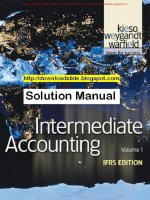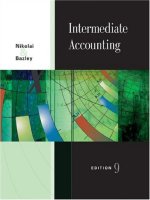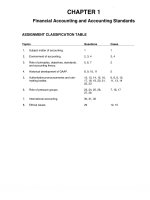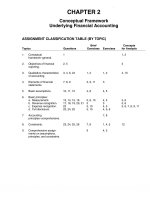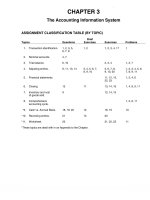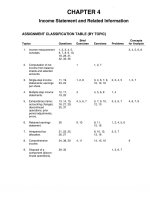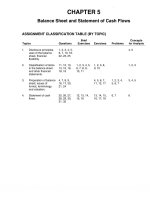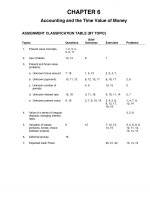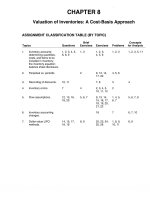Solution manual intermediate accounting IFRS volume 1 kiesoch16
Bạn đang xem bản rút gọn của tài liệu. Xem và tải ngay bản đầy đủ của tài liệu tại đây (1.08 MB, 63 trang )
To download more slides, ebook, solutions and test bank, visit
CHAPTER 16
Dilutive Securities and Earnings Per Share
ASSIGNMENT CLASSIFICATION TABLE (BY TOPIC)
Topics
Questions
Brief
Exercises
Exercises
Problems
Concepts
for Analysis
1.
Convertible debt
and preference
shares.
1, 2, 3, 4,
5, 6, 7, 27
1, 2, 3
1, 2, 3, 4, 5,
6, 7, 25, 26
1
2.
Warrants and debt.
3, 8, 9
4, 5
7, 8, 9,
10, 29
1, 3
3.
Share options,
restricted share.
1, 10, 11,
12, 13,
14, 15
6, 7, 8
11, 12, 13,
14, 15
4.
Earnings Per Share
(EPS)—terminology.
17, 18, 24
15
5.
EPS—Determining
potentially dilutive
securities.
19, 20, 21
12, 13, 14
6.
EPS—Treasury share
method.
22, 23
7.
EPS—Weightedaverage computation.
16, 17
10, 11
8.
EPS—General
objectives.
24, 25
9, 15
9.
EPS—Comprehensive
calculations.
26, 28
10.
EPS—Contingent
shares.
11.
Convergence issues.
*12.
1, 2, 3
2, 4
6
23, 24, 25,
26, 27, 28
5, 7
29
1, 5, 7
16, 17, 18,
19, 22
4, 5, 6,
7,8
5, 6, 7
20, 21, 22,
23, 24, 25,
27, 28, 29
4, 6, 7, 8
4, 5
29
26, 27
Share appreciation
rights.
16
30, 31
*This material is dealt with in an Appendix to the chapter.
Copyright © 2011 John Wiley & Sons, Inc.
Kieso Intermediate: IFRS Edition, Solutions Manual
16-1
To download more slides, ebook, solutions and test bank, visit
ASSIGNMENT CLASSIFICATION TABLE (BY LEARNING OBJECTIVE)
Brief
Exercises
Learning Objectives
Exercises
Problems
1
1. Describe the accounting for the issuance,
conversion, and retirement of convertible
securities.
1, 2
1, 2, 3, 4,
5, 6, 7
2. Explain the accounting for convertible
preference shares.
3
25, 26
3. Contrast the accounting for share warrants and for
share warrants issued with other securities.
4, 5
7, 8, 9, 10
1
4. Describe the accounting for share compensation
plans.
6, 7, 8
11, 12,13,
14, 15
1, 2, 3
6. Compute earnings per share in a simple
capital structure
9, 10,
11, 15
16, 17, 18, 19,
20, 21, 22
5, 8
7. Compute earnings per share in a complex
capital structure.
12, 13, 14
23, 24, 25, 26,
27, 28, 29
4, 6, 7
16
30, 31
5. Discuss the controversy involving share
compensation plans.
*8. Explain the accounting for share-appreciation
rights plans.
*9. Compute earnings per share in
a complex situation.
*This material is dealt with in an Appendix to the chapter.
16-2
Copyright © 2011 John Wiley & Sons, Inc.
Kieso Intermediate: IFRS Edition, Solutions Manual
To download more slides, ebook, solutions and test bank, visit
ASSIGNMENT CHARACTERISTICS TABLE
Item
Description
Level of
Difficulty
Time
(minutes)
E16-1
E16-2
E16-3
E16-4
E16-5
E16-6
E16-7
E16-8
E16-9
E16-10
E16-11
E16-12
E16-13
E16-14
E16-15
E16-16
E16-17
E16-18
E16-19
E16-20
E16-21
E16-22
E16-23
E16-24
E16-25
E16-26
E16-27
E16-28
E16-29
*E16-30
*E16-31
Issuance and repurchase of convertible bonds.
Issuance and repurchase of convertible bonds.
Issuance and repurchase of convertible bonds.
Issuance, conversion, repurchase of convertible bonds.
Conversion of bonds.
Conversion of bonds.
Issuance and conversion of bonds.
Issuance of bonds with warrants.
Issuance of bonds with share warrants.
Issuance of bonds with share warrants.
Issuance and exercise of share options.
Issuance, exercise, and forfeiture of share options.
Issuance, exercise, and expiration of share options.
Accounting for restricted shares.
Accounting for restricted shares.
Weighted-average number of shares.
EPS: Simple capital structure.
EPS: Simple capital structure.
EPS: Simple capital structure.
EPS: Simple capital structure.
EPS: Simple capital structure.
EPS: Simple capital structure.
EPS with convertible bonds, various situations.
EPS with convertible bonds.
EPS with convertible bonds and preference shares.
EPS with convertible bonds and preference shares.
EPS with options, various situations.
EPS with contingent issuance agreement.
EPS with warrants.
Share-appreciation rights.
Share-appreciation rights.
Moderate
Moderate
Moderate
Moderate
Simple
Simple
Simple
Simple
Simple
Moderate
Moderate
Moderate
Moderate
Simple
Simple
Moderate
Simple
Simple
Simple
Simple
Simple
Simple
Complex
Moderate
Moderate
Moderate
Moderate
Simple
Moderate
Moderate
Moderate
10–15
15–20
15–20
15–20
15–20
10–15
15–20
10–15
10–15
15–20
15–25
15–25
15–25
10–15
10–15
15–25
10–15
10–15
10–15
20–25
10–15
10–15
20–25
15–20
20–25
10–15
20–25
10–15
15–20
15–25
15–25
P16-1
P16-2
P16-3
P16-4
P16-5
P16-6
P16-7
P16-8
Entries for various dilutive securities.
Share-option plan.
Share-based compensation.
EPS with complex capital structure.
Basic EPS: Two-year presentation.
Computation of basic and diluted EPS.
Computation of basic and diluted EPS.
EPS with share dividend and discontinued operations.
Moderate
Moderate
Moderate
Moderate
Moderate
Moderate
Moderate
Complex
35–40
30–35
25–30
30–35
30–35
35–45
25–35
30–40
CA16-1
CA16-2
CA16-3
CA16-4
CA16-5
CA16-6
CA16-7
Dilutive securities, EPS.
Ethical issues—compensation plan.
Share warrants—various types.
Share compensation plans.
EPS: Preferred dividends, options, and convertible debt.
EPS concepts and effect of transactions on EPS.
EPS, antidilution.
Moderate
Simple
Moderate
Moderate
Moderate
Moderate
Moderate
15–20
15–20
15–20
25–35
25–35
25–35
25–35
Copyright © 2011 John Wiley & Sons, Inc.
Kieso Intermediate: IFRS Edition, Solutions Manual
16-3
To download more slides, ebook, solutions and test bank, visit
ANSWERS TO QUESTIONS
1.
Securities such as convertible debt or share options are dilutive because their features indicate that
the holders of the securities can become shareholders. When the ordinary shares are issued, there
will be a reduction—dilution—in earnings per share.
2.
Corporations issue convertible securities for two reasons. One is to raise equity capital without giving
up more ownership control than necessary. A second reason is to obtain financing at cheaper rates.
The conversion privilege attracts investors willing to accept a lower interest rate than on a straight
debt issue.
3.
Convertible debt and debt issued with share warrants are similar in that: (1) both allow the issuer to
issue debt at a lower interest cost than would generally be available for straight debt; (2) both allow
the holders to purchase the issuer’s shares at less than market value if the shares appreciates
sufficiently in the future; (3) both provide the holder the protection of a debt security if the value of the
shares does not appreciate; and (4) both are complex securities which contain elements of debt and
equity at the time of issue.
4.
The accounting treatment of the €160,000 ―sweetener‖ to induce conversion of the bonds into ordinary
shares represents a departure from IFRS because the IASB views the transaction as the retirement
of debt. Therefore, the IASB requires that the ―sweetener‖ of €160,000 be reported as an expense.
5.
(a) From the point of view of the issuer, the conversion feature of convertible debt results in a lower
cash interest cost than in the case of nonconvertible debt. In addition, the issuer in planning its
long-range financing may view the convertible debt as a means of raising equity capital over the
long term. Thus, if the market value of the underlying shares increases sufficiently after the
issue of the debt, the issuer will usually be able to force conversion of the convertible debt into
shares by calling the issue for redemption. Under the market conditions, the issuer can
effectively eliminate the debt. On the other hand, if the market value of the shares does not
increase sufficiently to result in the conversion of the debt, the issuer will have received the
benefit of the cash proceeds to the scheduled maturity dates at a relatively low cash interest
cost.
(b) The purchaser obtains an option to receive either the face amount of the debt upon maturity or
the specified number of shares upon conversion. If the market value of the underlying shares
increases above the conversion price, the purchaser (either through conversion or through
holding the convertible debt containing the conversion option) receives the benefits of
appreciation. On the other hand, should the value of the underlying company shares not
increase, the purchaser could nevertheless expect to receive the principal and (lower) interest.
6.
16-4
The view that separate accounting recognition should be accorded the conversion feature of
convertible debt is based on the premise that there is an economic value inherent in the conversion
feature or call on the ordinary shares and that the value of this feature should be recognized for
accounting purposes by the issuer. It may be argued that the call is not significantly different in nature
from the call contained in an option or warrant and its issue is thus a type of capital transaction. The
fact that the conversion feature coexists with certain senior security characteristics in a complex
security and cannot be physically separated from these elements or from the instrument does not
constitute a logical or compelling reason why the values of the various elements should not receive
separate accounting recognition. The fact that the eventual outcome of the option granted the
purchaser of the convertible debt cannot be determined at date of issuance is not relevant to
the question of effectively reflecting in the accounting records the various elements of the complex
document at the date of issuance. The conversion feature has a value at date of issuance and should
be recognized. Moreover, the difficulties of implementation are not insurmountable and should not be
relied upon to govern the conclusion.
Copyright © 2011 John Wiley & Sons, Inc.
Kieso Intermediate: IFRS Edition, Solutions Manual
To download more slides, ebook, solutions and test bank, visit
Questions Chapter 16 (Continued)
7.
The method used by the company to record the exchange of convertible debentures for ordinary
shares can be supported on the grounds that when the company issued the convertible debentures,
the proceeds could represent consideration received for the shares. Therefore, when conversion
occurs, the book value of the obligation is simply transferred to the shares exchanged for it. Further
justification is that conversion represents a transaction with shareholders which should not give rise
to a gain or loss.
On the other hand, recording the issue of the ordinary shares at the book value of the debentures is
open to question. It may be argued that the exchange of the shares for the debentures completes
the transaction cycle for the debentures and begins a new cycle for the shares. The consideration or
value used for this new transaction cycle should then be the amount which would be received if the
debentures were sold rather than exchanged, or the amount which would be received if the related
shares were sold, whichever is more clearly determinable at the time of the exchange. This method
recognizes changes in values which have occurred and subordinates a consideration determined at
the time the debentures were issued.
8.
Cash ...............................................................................................
Bonds Payable ........................................................................
Share Premium-Share Warrants .............................................
3,000,000
2,900,000
100,000
9.
If a corporation decides to issue new shares, the old shareholders generally have the right, referred to
as a share right, to purchase newly issued shares in proportion to their holdings. No entry is required
when rights are issued to existing shareholders. Only a memorandum entry is needed to indicate that
the rights have been issued. If exercised, the corporation simply debits Cash for the proceeds
received, credits Share Capital—Ordinary for the par value, and any difference is recorded with
a credit to Share Premium—Ordinary.
10.
Companies are required to use the fair value method to recognize compensation cost. For most share
option plans compensation cost is measured at the grant date and allocated to expense over the
service period, which typically ends on the vesting date.
11.
Gordero would account for the discount as a reduction of the cash proceeds and an increase in
compensation expense. The IASB concluded that this benefit represents employee compensation.
12.
The profession recommends that the fair value of a share option be determined on the date on which
the option is granted to a specific individual.
At the date the option is granted, the corporation foregoes the alternative of selling the shares at the
then prevailing price. The market price on the date of grant may be presumed to be the value which
the employer had in mind. It is the value of the option at the date of grant, rather than the grantor’s
ultimate gain or loss on the transaction, which for accounting purposes constitutes whatever compensation the grantor intends to pay.
13.
IFRS requires that compensation expense be recognized over the service period. Unless otherwise
specified, the service period is the vesting period—the time between the grant date and the vesting
date.
14.
Using the fair value approach, total compensation expense is computed based on the fair value of
the options on the date the options are granted to the employees. Fair value is estimated using an
acceptable option pricing model (such as the Black-Scholes option-pricing model).
Copyright © 2011 John Wiley & Sons, Inc.
Kieso Intermediate: IFRS Edition, Solutions Manual
16-5
To download more slides, ebook, solutions and test bank, visit
Questions Chapter 16 (Continued)
15.
16.
The advantages of using restricted shares to compensate employees are: (1) The restricted shares
never become completely worthless; (2) they generally result in less dilution than share options; and
(3) they better align the employee incentives with the companies incentives.
Weighted-average shares outstanding
Outstanding shares (all year) = ......................................................
October 1 to December 31 (200,000 X 1/4) =.................................
Weighted average ..........................................................................
Net income ............................................................................................
Preference dividends .............................................................................
Income available to common shareholders ............................................
Earnings per share =
$1,350,000
450,000
400,000
50,000
450,000
$1,750,000
400,000
$1,350,000
= $3.00
17.
The computation of the weighted-average number of shares requires restatement of the shares
outstanding before the share dividend or split. The additional shares outstanding as a result of a
share dividend or split are assumed to have been outstanding since the beginning of the year.
Shares outstanding prior to the share dividend or split are adjusted so that these shares are stated
on the same basis as shares issued after the share dividend/split.
18.
(a) Basic earnings per share is the amount of earnings for the period available to each ordinary
share outstanding during the reporting period.
(b) A potentially dilutive security is a security which can be exchanged for or converted into ordinary
shares and therefore upon conversion or exercise could dilute (or decrease) earnings per share.
Included in this category are convertible securities, options, warrants, and other rights.
(c)
Diluted earnings per share is the amount of earnings for the period available to each ordinary
share outstanding and to each share that would have been outstanding assuming the issuance
of ordinary shares for all dilutive potential ordinary shares outstanding during the reporting
period.
(d) A complex capital structure exists whenever a company’s capital structure includes dilutive
securities.
(e) Potential ordinary shares are not ordinary shares in form but do enable their holders to obtain
ordinary shares upon exercise or conversion.
19.
Convertible securities are potentially dilutive securities and part of diluted earnings per share if their
conversion increases the EPS numerator less than it increases the EPS denominator; i.e., the EPS
after conversion is less than the EPS before conversion.
20.
The concept that a security may be the equivalent of common stock has evolved to meet the
reporting needs of investors in corporations that have issued certain types of convertible securities,
options, and warrants. A potentially dilutive security is a security which is not, in form, common stock
but which enables its holder to obtain common stock upon exercise or conversion. The holders of
these securities can expect to participate in the appreciation of the value of the common stock resulting
principally from the earnings and earnings potential of the issuing corporation. This participation is
essentially the same as that of a common stockholder except that the security may carry a specified
dividend yielding a return different from that received by a common stockholder. The attractiveness to
investors of this type of security is often based principally upon this potential right to share in increases
in the earnings potential of the issuing corporation rather than upon its fixed return or upon other
senior security characteristics. In addition, the call characteristic of the stock options and warrants gives
the investor potential control over a far greater number of shares per dollar of investment than if the
investor owned the shares outright.
16-6
Copyright © 2011 John Wiley & Sons, Inc.
Kieso Intermediate: IFRS Edition, Solutions Manual
To download more slides, ebook, solutions and test bank, visit
Questions Chapter 16 (Continued)
21.
Convertible securities are considered to be potentially dilutive securities whenever their conversion
would decrease earnings per share. If this situation does not result, conversion is not assumed and
only basic EPS is reported.
22.
Under the treasury share method, diluted earnings per share should be determined as if outstanding
options and warrants were exercised at the beginning of year (or date of issue if later) and the funds
obtained thereby were used to purchase ordinary shares at the average market price for the period.
For example, if a corporation has 10,000 warrants outstanding exercisable at $54, and the average
market price of the ordinary shares during the reported period is $60, the $540,000 which would be
realized from exercise of warrants and issuance of 10,000 shares would be an amount sufficient to
acquire 9,000 shares; thus, 1,000 shares would be added to the outstanding ordinary shares in
computing diluted earnings per share for the period. However, to avoid an incremental positive effect
upon earnings per share, options and warrants should enter into the computation only when the
average market price of the ordinary shares exceeds the exercise price of the option or warrant.
23.
Yes, if warrants or options are present, an increase in the market price of the ordinary shares can
increase the number of potentially dilutive ordinary shares by decreasing the number of shares
repurchasable. In addition, an increase in the market price of ordinary shares can increase the
compensation expense reported in a share appreciation rights plan. This would decrease net income
and, consequently, earnings per share.
24.
Antidilution is an increase in earnings per share resulting from the assumption that convertible
securities have been converted or that options and warrants have been exercised, or other shares
have been issued upon the fulfillment of certain conditions. For example, an antidilutive condition
would exist when the dividend or interest requirement (net of tax) of a convertible security exceeds
the current EPS multiplied by the number of ordinary shares issuable upon conversion of the
security. This may be illustrated by assuming a company in the following situation:
Net income ............................................................................................................
Outstanding ordinary shares ..................................................................................
Interest expense on convertible bonds payable
(convertible into 5,000 ordinary shares) ..............................................................
Tax rate .................................................................................................................
$ 10,000
20,000
$6,000
40%
Basic earnings per share = $10,000/20,000 shares = $.50
Earnings per share assuming conversion of the bonds:
Net income......................................................................................................
Bond interest (net of tax) = (1 – .40) ($100,000 X .06) ....................................
Adjusted net income .......................................................................................
Earnings per share assuming conversion =
$13,600
20,000 + 5,000
$10,000
3,600
$13,600
= $.54
This antidilutive effect occurs because the bond interest (net of tax) of $3,600 is greater than the
current EPS of $.50 multiplied by the number of shares issuable upon conversion of the bonds (5,000
shares).
25.
Both basic earnings per share and diluted earnings per share must be presented in a complex capital
structure. When discontinued operations are reported, per share amounts should be shown for
income from continuing operations, and net income.
26.
IFRS and U.S. GAAP are substantially the same in the accounting for share-based compensation.
For example, both IFRS and U.S. GAAP follow the same model for recognizing share-based
compensation. That is, the fair value of shares and options awarded to employees is recognized over
the period to which the employees’ services relate.
Copyright © 2011 John Wiley & Sons, Inc.
Kieso Intermediate: IFRS Edition, Solutions Manual
16-7
To download more slides, ebook, solutions and test bank, visit
Questions Chapter 16 (Continued)
27. (a) Under IFRS, Norman must ―bifurcate‖ (split out) the equity component—the value of the conversion
option—of the bond issue. Under iGAAP, the convertible bond issue is recorded as follows.
Cash .............................................................................................................
Bonds Payable ........................................................................................
Share Premium—Conversion Equity .......................................................
400,000
365,000
35,000
(b) Norman makes the following entry to record the issuance under U.S. GAAP.
Cash .............................................................................................................
Bonds Payable ........................................................................................
(c)
400,000
400,000
IFRS provides a more faithful representation of the impact of the bond issue, by recording
separately its debt and equity components. However, there are concerns about reliability of the
models used to estimate the equity portion of the bond issue.
*28. Antidilution when multiple securities are involved is determined by ranking the securities for
maximum possible dilution in terms of per share effect. Starting with the most dilutive, earnings per
share is reduced until one of the securities maintains or increases earnings per share. When an
increase in earnings per share occurs, the security that causes the increase in earnings per share is
excluded. The previous computation therefore provided the maximum dilution.
16-8
Copyright © 2011 John Wiley & Sons, Inc.
Kieso Intermediate: IFRS Edition, Solutions Manual
To download more slides, ebook, solutions and test bank, visit
SOLUTIONS TO BRIEF EXERCISES
BRIEF EXERCISE 16-1
Cash (£4,000,000 X .99) ...............................................
Bonds Payable .....................................................
Share Premium—Conversion Equity .................
3,960,000
3,800,000
160,000
BRIEF EXERCISE 16-2
Share Premium—Conversion Equity ........................
Bonds Payable ...........................................................
Share Capital—Ordinary (2,000 X 50 X €10) ......
Share Premium—Ordinary .................................
20,000
1,950,000
1,000,000
970,000
BRIEF EXERCISE 16-3
Share Capital—Preference (1,000 X $50) ...................
Share Premium—Conversion Equity
($60 – $50) X 1,000....................................................
Share Capital—Ordinary (2,000 X $10) ...............
Share Premium—Ordinary
($60 X 1,000) – (2,000 X $10) ............................
50,000
10,000
20,000
40,000
BRIEF EXERCISE 16-4
Cash [2,000 X ($1,000 X 1.01)] ....................................
Bonds Payable .....................................................
Share Premium-Share Warrants .........................
2,020,000
1,970,000
50,000
BRIEF EXERCISE 16-5
Cash 3,000 X (€1,000 X .98) .........................................
Bonds Payable .....................................................
Share Premium—Stock Warrants .......................
Copyright © 2011 John Wiley & Sons, Inc.
2,940,000
Kieso Intermediate: IFRS Edition, Solutions Manual
2,910,000
30,000
16-9
To download more slides, ebook, solutions and test bank, visit
BRIEF EXERCISE 16-6
1/1/10
No entry
12/31/10
Compensation Expense ...............................
Share Premium—Share
Options ..............................................
75,000
Compensation Expense ...............................
Share Premium—Share
Options ..............................................
75,000
12/31/11
75,000
75,000
BRIEF EXERCISE 16-7
1/1/10
12/31/10
12/31/11
Unearned Compensation .............................
Share Capital—Ordinary
(2,000 X $5) ........................................
Share Premium—Ordinary
[($65 – $5) X 2,000] ............................
130,000
Compensation Expense ...............................
Unearned Compensation ......................
65,000
Compensation Expense ...............................
Unearned Compensation ......................
65,000
10,000
120,000
65,000
65,000
BRIEF EXERCISE 16-8
1/1/10
12/31/10
16-10
Unearned Compensation .............................
Share Capital—Ordinary .......................
Share Premium—Ordinary ...................
75,000
Compensation Expense ...............................
Unearned Compensation
($75,000 ÷ 3) ........................................
25,000
Copyright © 2011 John Wiley & Sons, Inc.
10,000
65,000
25,000
Kieso Intermediate: IFRS Edition, Solutions Manual
To download more slides, ebook, solutions and test bank, visit
BRIEF EXERCISE 16-9
€1,000,000 – (100,000 X €2)
250,000 shares
= €3.20 per share
BRIEF EXERCISE 16-10
Dates
Outstanding
Shares
Outstanding
Fraction
of Year
Weighted
Shares
1/1–5/1
5/1–7/1
7/1–10/1
10/1–12/31
120,000
180,000
170,000
180,000
4/12
2/12
3/12
3/12
40,000
30,000
42,500
45,000
157,500
BRIEF EXERCISE 16-11
(a) (300,000 X 4/12) + (330,000 X 8/12) = 320,000
(b) 330,000 (The 30,000 shares issued in the share dividend are assumed outstanding from the beginning of the year.)
BRIEF EXERCISE 16-12
Net income ..................................................................................
Adjustment for interest, net of tax [R64,000 X (1 – .40)] ..........
Adjusted net income ..................................................................
Weighted average number of shares adjusted for
dilutive securities (100,000 + 16,000) ....................................
Diluted EPS .................................................................................
R300,000
38,400
R338,400
÷116,000
R2.92
BRIEF EXERCISE 16-13
Net income .................................................................................
Weighted average number of shares adjusted
for dilutive securities (50,000 + 10,000) ...............................
Diluted EPS ................................................................................
Copyright © 2011 John Wiley & Sons, Inc.
Kieso Intermediate: IFRS Edition, Solutions Manual
$270,000
÷ 60,000
$4.50
16-11
To download more slides, ebook, solutions and test bank, visit
BRIEF EXERCISE 16-14
Proceeds from assumed exercise of 45,000
options (45,000 X $10) ...........................................................
Shares issued upon exercise ...................................................
Treasury shares purchasable ($450,000 ÷ $15) .......................
Incremental shares ....................................................................
Diluted EPS =
$300,000
=
200,000 + 15,000
$450,000
45,000
30,000
15,000
$1.40
BRIEF EXERCISE 16-15
Earnings per share
Income from continuing operations (€600,000/100,000) .......
Discontinued operations loss (€120,000/100,000) .................
Net income (€480,000/100,000) ................................................
€ 6.00
(1.20)
€ 4.80
*BRIEF EXERCISE 16-16
2010:
(5,000 X $4) X 50% = $10,000
2011:
(5,000 X $9) – $10,000 = $35,000
16-12
Copyright © 2011 John Wiley & Sons, Inc.
Kieso Intermediate: IFRS Edition, Solutions Manual
To download more slides, ebook, solutions and test bank, visit
SOLUTIONS TO EXERCISES
EXERCISE 16-1 (10–15 minutes)
(a) Present Value of Principal:
(€2,000,000 X .79383) ............................................................
Present Value of Interest Payments:
(€120,000 X 2.57710) .............................................................
Present Value of the Liability Component .............................
Fair Value of Convertible Debt ................................................
Less: Fair Value of Liability Component ................................
Fair Value of Equity Component .............................................
(b) Cash....................................................................
Bonds Payable ............................................
Share Premium—Conversion Equity .........
2,000,000
(c) Bonds Payable ...................................................
Cash .............................................................
2,000,000
€1,587,660
309,252
€1,896,912
€2,000,000
1,896,912
€ 103,088
1,896,912
103,088
2,000,000
EXERCISE 16-2 (15–20 minutes)
(a) Carrying Value of Bonds, 1-1-11
(from Ex. 16–1(a))....................................................................
Discount Amortized in 2011
[(€1,896,912 X .08) – €120,000)] ..............................................
Carrying Value of Bonds, 1-1-12 ...............................................
(b) Share Premium—Conversion Equity ...........
Bonds Payable ...............................................
Share Capital—Ordinary.........................
Share Premium—Ordinary .....................
€1,896,912
31,753
€1,928,665
103,088
1,928,665
500,000
1,531,753*
*€103,088 + €1,928,665 – €500,000
Copyright © 2011 John Wiley & Sons, Inc.
Kieso Intermediate: IFRS Edition, Solutions Manual
16-13
To download more slides, ebook, solutions and test bank, visit
EXERCISE 16-2 (Continued)
(c) Share Premium—Conversion Equity ...........
Bonds Payable ..............................................
Cash ........................................................
Gain on Repurchase ..............................
40,000*
1,928,665
1,940,000
28,665**
* €1,940,000 – €1,900,000 (Fair value of convertible bond issue (both liability
and equity components less the fair value of the liability component).
The remaining balance in this account could be transferred to Share
Premium—Ordinary.
**€1,928,665 – €1,900,000 (Angela has a gain because the repurchase
amounts of the liability component is less than the carrying value of the
liability component.)
EXERCISE 16-3 (15–20 minutes)
(a) Present Value of Principal:
(¥100,000 X .59345) ...............................................
Present Value of Interest Payments:
(¥10,000 X 3.69590) ...............................................
Present Value of the Liability Component .............
Fair Value of the convertible bonds
(including both the liability and
equity components) ..............................................
Less: Fair value of liability component
(from above)..................................................
Equity component....................................................
Cash ..........................................................................
Bonds Payable ..................................................
Share Premium—Conversion Equity ...............
(b)
Date
1/1/11
12/31/11
12/31/12
12/31/13
16-14
Cash
Paid
Interest
Expense
Discount
Amortized
¥10,000
¥10,000
¥10,000
¥10,593
10,659
10,731
¥593
659
731
Copyright © 2011 John Wiley & Sons, Inc.
¥ 59,345
36,959
¥ 96,304
¥100,000
96,304
¥ 3,696
100,000
96,304
3,696
Carrying Value
of Bonds
¥96,304
96,897
97,556
98,287
Kieso Intermediate: IFRS Edition, Solutions Manual
To download more slides, ebook, solutions and test bank, visit
EXERCISE 16-3 (Continued)
Computation of gain or loss:
Present value of liability component at
1/1/14 (n=7, I = 8%) .........................................
Carrying value (from above) ............................
Loss ...................................................................
¥110,413*
98,287
¥ 12,126
* 10,000 X 5.20637 = ¥ 52,064
100,000 X .58349 =
58,349
¥110,413
Adjustment to equity:
Fair value of convertible bonds
(with both liability and equity) .......................
Less: Liability component ...............................
Adjustment to Share Premium—
Conversion Equity .........................................
Share Premium—Conversion Equity .....................
Bonds Payable .........................................................
Loss on Repurchase ...............................................
Cash ...................................................................
¥112,000
110,413
¥
1,587
1,587*
98,287
12,126
112,000
*The remaining balance in this account could be transferred to Share
Premium—Ordinary.
EXERCISE 16-4 (15–20 minutes)
(a) Cash..........................................................................
Bonds Payable ..................................................
Share Premium—Conversion Equity ...............
60,000
(b) Interest Expense ......................................................
Bonds Payable .........................................................
Cash ...................................................................
4,265
735
(c) Share Premium—Conversion Equity .....................
Bonds Payable .........................................................
Share Capital—Ordinary (6,000 X $1) ..............
Share Premium—Ordinary ...............................
6,007
51,783
Copyright © 2011 John Wiley & Sons, Inc.
Kieso Intermediate: IFRS Edition, Solutions Manual
53,993
6,007
5,000
6,000
51,790
16-15
To download more slides, ebook, solutions and test bank, visit
EXERCISE 16-4 (Continued)
(d) Computation of gain or loss:
Present value of liability component
at 12/31/13 .......................................................
Less: Carrying value (from above) .................
Loss ...................................................................
Adjustment to equity:
Fair value of convertible bonds
(with both liability and equity) .......................
Less: Liability component ...............................
Adjustment to Share Premium—Conversion
Equity ..............................................................
$54,000
51,783
$ 2,217
$55,500
54,000
$ 1,500
Share Premium—Conversion Equity ......................
Bonds Payable .........................................................
Loss on Repurchase ................................................
Cash ...................................................................
1,500
51,783
2,217
(e) Interest Expense ......................................................
Bonds Payable .........................................................
Cash ...................................................................
4,074
926
Bonds Payable .........................................................
Cash ...................................................................
50,000
55,500
5,000
50,000
EXERCISE 16-5 (15–20 minutes)
(a) Cash (€3,000,000 X .98) ............................................
Bonds Payable ..................................................
Share Premium—Conversion Equity ...............
2,940,000
(b) Interest Expense (€2,800,000 X 11% ÷ 2) ..................
Bonds Payable ..................................................
Cash (€3,000,000 X 10% ÷ 2) .............................
154,000
(c) Interest Expense (€2,804,000 X 11% ÷ 2) ................
Bonds Payable ..................................................
Cash ...................................................................
154,220
16-16
Copyright © 2011 John Wiley & Sons, Inc.
2,800,000
140,000
4,000
150,000
4,220
150,000
Kieso Intermediate: IFRS Edition, Solutions Manual
To download more slides, ebook, solutions and test bank, visit
EXERCISE 16-5 (Continued)
Share Premium—Conversion Equity
(140,000 X 1/3) ....................................................
Bonds Payable ......................................................
Share Capital—Ordinary (30,000 X €20).......
Share Premium—Ordinary ...........................
46,667
936,073*
600,000
382,740
*(€2,804,000 + €4,220) X 1/3
EXERCISE 16-6 (10–15 minutes)
Conversion recorded at book value of the bonds:
Share Premium—Conversion Equity ..........................
Bonds Payable .............................................................
Share Capital—Preference (400 X 20 X $50) .......
Share Premium—Preference ...............................
3,500
406,000
400,000
2,500
EXERCISE 16-7 (15–20 minutes)
1.
2.
3.
Cash (€10,000,000 X .99).......................................
Bonds Payable (10,000,000 X .95) .................
Share Premium—Conversion Equity ............
9,900,000
Cash (€10,000,000 X .98).......................................
Bonds Payable ...............................................
Share Premium—Share Warrants .................
9,800,000
Share Premium—Conversion Equity ..................
Conversion Expense ............................................
Bonds Payable ......................................................
Share Capital—Ordinary................................
Share Premium—Ordinary ............................
Cash ................................................................
200,000
75,000
9,700,000
9,500,000
400,000
9,600,000
200,000
1,000,000
8,900,000*
75,000
*[(€9,700,000 + €200,000) – €1,000,000]
Copyright © 2011 John Wiley & Sons, Inc.
Kieso Intermediate: IFRS Edition, Solutions Manual
16-17
To download more slides, ebook, solutions and test bank, visit
EXERCISE 16-8 (10–15 minutes)
(a) Cash .......................................................................
Bonds Payable ...............................................
Share Premium—Share Warrants .................
150,000
136,000
14,000
(b) Even if the warrants were nondetachable, the entry in (a) would be the same.
Any debt issued with warrants is considered a compound instrument for
accounting purposes.
EXERCISE 16-9 (10–15 minutes)
LIN COMPANY
Journal Entry
September 1, 2010
Cash (¥312,000,000 + ¥6,000,000) .............................. 318,000,000
Bonds Payable (3,000 X ¥1,000) ....................
290,000,000
Share Premium—Share Warrants—
Schedule 1 ...................................................
22,000,000
Bond Interest Expense—Schedule 2 ............
6,000,000
(To record the issuance of the bonds)
Schedule 1
Value of Share Warrants
Sales price (30,000 X ¥10,400) .................................................
Present value of bonds ............................................................
Net value of share warrants .....................................................
¥312,000,000
290,000,000
¥ 22,000,000
Schedule 2
Accrued Bond Interest to Date of Sale
Face value of bonds .................................................................
Interest rate ...............................................................................
Annual interest .........................................................................
¥300,000,000
X
8%
¥ 24,000,000
Accrued interest for 3 months – (¥24,000,000 X 3/12)............
¥
16-18
Copyright © 2011 John Wiley & Sons, Inc.
6,000,000
Kieso Intermediate: IFRS Edition, Solutions Manual
To download more slides, ebook, solutions and test bank, visit
EXERCISE 16-10 (15–20 minutes)
(a) Cash (€3,000,000 X 1.02)......................................
Bonds Payable ................................................
Share Premium—Share Warrants ..................
3,060,000
2,940,000
120,000*
*$3,060,000 – ($2,940,000)
(b) Cash......................................................................
Bonds Payable ................................................
Share Premium—Share Warrants ..................
3,060,000
2,940,000
120,000*
*Note: IFRS requires determining the equity component as
a residual. Answer is same as (a).
EXERCISE 16-11 (15–25 minutes)
1/2/10 No entry (total compensation cost is $600,000)
12/31/10
12/31/11
1/3/12
Compensation Expense .................................
Share Premium—Share Options.............
[To record compensation expense
for 2010 (1/2 X $600,000)]
300,000
Compensation Expense ..................................
Share Premium—Share Options.............
[To record compensation expense
for 2011 (1/2 X $600,000)]
300,000
300,000
Cash (30,000 X $40) ......................................... 1,200,000
Share Premium—Share Options
($600,000 X 30,000/40,000) ...........................
450,000
Share Capital—Ordinary
(30,000 X $10) ........................................
Share Premium—Ordinary ......................
(To record issuance of 30,000
$10 par value shares
upon exercise of options at
option price of $40)
Copyright © 2011 John Wiley & Sons, Inc.
Kieso Intermediate: IFRS Edition, Solutions Manual
300,000
300,000
1,350,000
16-19
To download more slides, ebook, solutions and test bank, visit
EXERCISE 16-11 (Continued)
(Note to instructor: The market price of the shares has no relevance in the
prior entry and the following one.)
5/1/12
Cash (10,000 X $40) .........................................
Share Premium—Share Options
($600,000 X 10,000/40,000) ..........................
Share Capital—Ordinary ..........................
Share Premium—Ordinary ......................
(To record issuance of 10,000
$10 par value shares
upon exercise of options at
option price of $40)
400,000
150,000
100,000
450,000
EXERCISE 16-12 (15–25 minutes)
1/1/10
No entry (total compensation cost is €400,000)
12/31/10
Compensation Expense ....................................
Share Premium—Share Options ............
(€400,000 X 1/2) (To recognize
compensation expense for 2010)
200,000
Share Premium—Share Options.......................
Compensation Expense
(€200,000 X 3,000/20,000).....................
(To record forfeiture of share
options held by resigned employees)
30,000
Compensation Expense ....................................
Share Premium—Share Options ............
(€400,000 X 1/2 X 17/20) (To recognize
compensation expense for 2011)
170,000
Cash (12,000 X €25) ...........................................
Share Premium—Share Options
(€400,000 X 12,000/20,000) .............................
Share Capital—Ordinary.........................
Share Premium—Ordinary .....................
(To record exercise of share options)
300,000
4/1/11
12/31/11
3/31/12
200,000
30,000
170,000
240,000
120,000
420,000
Note: There are 5,000 options unexercised as of 3/31/12 (20,000 – 3,000 – 12,000).
16-20
Copyright © 2011 John Wiley & Sons, Inc.
Kieso Intermediate: IFRS Edition, Solutions Manual
To download more slides, ebook, solutions and test bank, visit
EXERCISE 16-13 (15–25 minutes)
1/1/09
12/31/09
12/31/10
5/1/11
No entry (total compensation cost is $450,000)
Compensation Expense ...................................
Share Premium—Share Options
($450,000 X 1/2) .................................................
225,000
Compensation Expense ...................................
Share Premium—Share Options .....................
225,000
Cash (9,000 X $20) ............................................
Share Premium—Share Options .....................
Share Capital—Ordinary (9,000 X $5) .......
Share Premium—Ordinary ........................
180,000
405,000*
225,000
225,000
45,000
540,000
*($450,000 X 9,000/10,000)
1/1/13
Paid-in Capital—Share Options .......................
Share Premium—Expired Share
Options ($450,000 – $405,000)................
45,000
45,000
EXERCISE 16-14 (10–15 minutes)
(a) 1/1/10
Unearned Compensation .................................
Share Capital—Ordinary (4,000 X $5) .......
Share Premium—Ordinary ........................
120,000
12/31/11 Compensation Expense ...................................
Unearned Compensation ($120,000 ÷ 4) .....
30,000
(b) 3/4/12
Share Capital—Ordinary ..................................
Share Premium—Ordinary ...............................
Unearned Compensation...........................
Compensation Expense (2 X $30,000) ......
20,000
100,000
30,000
20,000
100,000
60,000
60,000
EXERCISE 16-15 (10–15 minutes)
(a) 1/1/10
Unearned Compensation .................................
Share Capital—Ordinary (€10 X 10,000) ...
Share Premium—Ordinary ........................
500,000
12/31/11 Compensation Expense (€500,000 ÷ 5) ...........
Unearned Compensation ............................
100,000
Copyright © 2011 John Wiley & Sons, Inc.
Kieso Intermediate: IFRS Edition, Solutions Manual
100,000
400,000
100,000
16-21
To download more slides, ebook, solutions and test bank, visit
EXERCISE 16-15 (Continued)
(b) 1/1/15
Share Capital—Ordinary .................................
Share Premium—Ordinary ..............................
Compensation Expense............................
100,000
400,000
500,000
EXERCISE 16-16 (15–25 minutes)
(a) 2,640,000 shares
Jan. 1, 2010–Sept. 30, 2010 (2,400,000 X 9/12) .......
Retroactive adjustment for share dividend ............
Jan. 1, 2010–Sept. 30, 2010, as adjusted ................
Oct. 1, 2010–Dec. 31, 2010 (2,640,000 X 3/12).........
1,800,000
X
1.10
1,980,000
660,000
2,640,000
Another way to view this transaction is that the 2,400,000 shares at the
beginning of the year must be restated for the share dividend regardless
of where in the year the share dividend occurs.
(b) 4,140,000 shares
Jan. 1, 2011–Mar. 31, 2011 (2,640,000 X 3/12)..........
Apr. 1, 2011–Dec. 31, 2011 (4,640,000 X 9/12) .........
(c) 8,280,000 shares
2011 weighted-average number of shares
previously computed ............................................
Retroactive adjustment for share split ....................
(d) 9,280,000 shares
Jan. 1, 2012–Mar. 31, 2012 (4,640,000 X 3/12) ..............
Retroactive adjustment for share split .........................
Jan. 1, 2012–Mar. 31, 2012, as adjusted .......................
Apr. 1, 2012–Dec. 31, 2012 (9,280,000 X 9/12) ..............
660,000
3,480,000
4,140,000
4,140,000
X
2
8,280,000
1,160,000
X
2
2,320,000
6,960,000
9,280,000
Another way to view this transaction is that the 4,640,000 shares at the
beginning of the year must be restated for the share split regardless of
where in the year the share split occurs.
16-22
Copyright © 2011 John Wiley & Sons, Inc.
Kieso Intermediate: IFRS Edition, Solutions Manual
To download more slides, ebook, solutions and test bank, visit
EXERCISE 16-17 (10–15 minutes)
(a)
Dates
Outstanding
Shares
Outstanding
Jan. 1–Feb. 1
Feb. 1–Mar. 1
Mar. 1–May 1
May 1–June 1
June 1–Oct. 1
Oct. 1–Dec. 31
480,000
600,000
720,000
620,000
1,860,000
1,920,000
Event
Beginning balance
Issued shares
Share dividend
Reacquired shares
Share split
Reissued shares
Restatement
1.2 X 3.0
1.2 X 3.0
3.0
3.0
Fraction
of Year
Weighted
Shares
1/12
1/12
2/12
1/12
4/12
3/12
144,000
180,000
360,000
155,000
620,000
480,000
1,939,000
Weighted-average number of shares outstanding
(b)
Earnings Per Share =
¥3,256,000,000 (Net Income)
1,939,000 (Weighted-Average Shares)
= ¥1,679.22
(c)
Earnings Per Share =
¥3,256,000,000 – ¥900,000
1,939,000
= ¥1,678.75
(d) Income from continuing operationsa.............................
Loss from discontinued operationsb .............................
Net income ......................................................................
a
Net income .....................................................................
Add loss from discontinued operations .......................
Income from continuing operations ..............................
¥3,688,000,000
1,939,000
b
¥
¥
1,902.01
(222.80)
1,679.21
¥3,256,000,000
432,000,000
¥3,688,000,000
= ¥1,902.01
¥ (432,000,000) = ¥ 222.80
1,939,000
Copyright © 2011 John Wiley & Sons, Inc.
Kieso Intermediate: IFRS Edition, Solutions Manual
16-23
To download more slides, ebook, solutions and test bank, visit
EXERCISE 16-18 (10–15 minutes)
Dates
Shares
Event
Outstanding
Outstanding
Beginning balance
Jan. 1–May 1
210,000
Issued shares
May 1–Oct. 31
218,000
Reacquired shares
Oct. 31–Dec. 31
204,000
Weighted-average number of shares outstanding
Fraction
of Year
4/12
6/12
2/12
Weighted
Shares
70,000
109,000
34,000
213,000
Income per share before discontinued operations loss
($229,690 + $40,600 = $270,290;
$270,290 ÷ 213,000 shares).......................................................
Discontinued operations loss per share, net of tax
($40,600 ÷ 213,000) ....................................................................
Net income per share ($229,690 ÷ 213,000) ................................
$1.27
(.19)
$1.08
EXERCISE 16-19 (10–15 minutes)
Event
Dates
Outstanding
Shares
Outstanding
Beginning balance
Jan. 1–May 1
600,000
Issued shares
May 1–Aug. 1
900,000
Reacquired shares
Aug. 1–Dec. 31
750,000
Weighted-average number of shares outstanding
Restatement
Fraction
of Year
Weighted
Shares
2
2
2
4/12
3/12
5/12
400,000
450,000
625,000
1,475,000
Net income ....................................................................................
Preference dividend (50,000 X ¥100 X 8%) .................................
¥2,200,000
(400,000)
¥1,800,000
Net income applicable to ordinary shares
= ¥1,800,000 = ¥1.22
Weighted-average number of shares outstanding
1,475,000
16-24
Copyright © 2011 John Wiley & Sons, Inc.
Kieso Intermediate: IFRS Edition, Solutions Manual
To download more slides, ebook, solutions and test bank, visit
EXERCISE 16-20 (20–25 minutes)
Earnings per ordinary share:
Income from continuing operations*...................................
Discontinued operations loss, net of tax** .........................
Net income*** ........................................................................
Income data:
Income from continuing operations ....................................
Deduct 6% dividend on preference shares .........................
Ordinary share income from discontinued operations ......
Deduct discontinued operations loss, net of tax ...............
Net income available for ordinary shareholders ................
Dates
Outstanding
Shares
Outstanding
Fraction
of Year
January 1–April 1
7,000,000
3/12
April 1–December 31
8,000,000
9/12
Weighted-average number of shares outstanding
$1.89
(.17)
$1.72
$15,000,000
300,000
14,700,000
1,340,000
$13,360,000
Weighted
Shares
1,750,000
6,000,000
7,750,000
*$14,700,000 ÷ 7,750,000 shares = $1.89 per share
(income from continuing operations)
**$1,340,000 ÷ 7,750,000 shares = ($.17) per share
(discontinued operations loss net of tax)
***$13,360,000 ÷ 7,750,000 shares = $1.72 per share
(net income)
EXERCISE 16-21 (10–15 minutes)
Income from continuing operations before taxes ......................
Income taxes ................................................................................
Income from continuing operations ...........................................
Discontinued operations gain, net of applicable
income tax of €36,000 ...............................................................
Net income ....................................................................................
€300,000
120,000
180,000
54,000
€234,000
Per ordinary share:
Income from continuing operations* ...................................
Discontinued operations gain, net of tax** ..........................
Net income*** .........................................................................
€.41
.18
€.59
Copyright © 2011 John Wiley & Sons, Inc.
16-25
Kieso Intermediate: IFRS Edition, Solutions Manual
